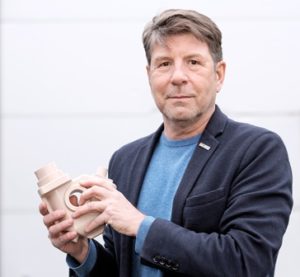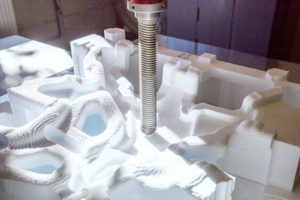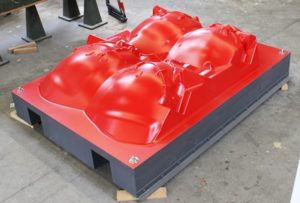When Moulding Expo opens its doors at the Stuttgart Trade Fair Centre on 30 May 2017, the focus will also again be on pattern and mould makers in addition to tool makers.
Pattern and mould makers represent a special exhibitor group which is firstly very diverse, but has also changed enormously in the last few years.
“By tradition, the industry is right at the front of the process chain between design and series production,” said Peter Gärtner from the Information Centre for Company Management in the German Association of Pattern and Mould Making (BVMF).
However, companies still pay very little attention to one of the traditional disciplines of foundry pattern making, body and production pattern making, and construction of display patterns, supplemented at times by mould and gauge manufacturing.
Gärtner: “It has been noticeable for years that the transitions are becoming more fluent, companies are increasingly expanding their horizons and are also involved in tool making.”
A large number of companies already cover the entire process chain. The companies in the industry therefore process a wide range of materials extending from wood, the traditional pattern material, and many different plastics through to lightweight and non-ferrous metals along with steel.
This also involves broad-based technological know-how and the willingness to face up to the challenge of increasingly more accurate tolerances – right down to the micrometre range.
The most important new technology is 3D printing or additive manufacturing (AM).
Especially using 3D printing, it is relatively easy to start series production, primarily objects in prototype construction and in pilot and small series manufacturing.
Peter Gärtner added, however, that 3D printing is also used by customers of pattern and mould manufacturers. For example, foundries are increasingly manufacturing casting moulds directly using 3D sand printers, especially for prototype casts.
Since a pattern set is no longer required in this case, this technology is starting to compete with traditional foundry pattern making.
On the other hand, 3D printers are providing pattern and mould makers with new work opportunities which must be utilised.
Peter Gärtner mentions as examples production planning and quality assurance of patterns for large moulds, e.g. for ship’s engines.
The 3D data are scaled and printed as a scaled-down model, thus making an unclear dataset clear. It can be more easily examined whether problems, for example, might occur during shaping.
“A printer can therefore be used creatively even if it will be a long time before a printer can print a ship’s engine pattern set,” said Peter Gärtner concluding the thought.
The engineer is at any rate delighted not only with the presentations by pattern and mould makers on the joint stand of the German Association of Pattern and Mould Making, but also with all the products and services which will be exhibited during Moulding Expo between 30 May and 2 June 2017.
Companies set to present the entire range
HFM Modell– und Formenbau GmbH, Ostrach, will take part in Moulding Expo in Stuttgart for the first time.
The company regards Moulding Expo as a “new fresh trade fair which is very well organised.”
HFM is convinced that Moulding Expo will become the “new leading trade fair” for the industry.
The Ostrach-based company operates in the areas of automotive, aerospace engineering, tool making and mechanical engineering, and started to fully use 3D printing last year.
“We will focus on the topics of cubing – i.e the presentation of entire modules – mould making and additive manufacturing.”
In addition to German customers, the company is expecting to welcome European customers, especially from neighbouring countries. MEX is also important for HFM to obtain an overview of new developments and trends in the industry. (Hall 4/C50)
CP – Centrum für Prototypenbau GmbH, Erkelenz, supports product developers with prototypes and small series made of plastic and metal.
The company will also be exhibiting in Stuttgart for the first time. Besima Sümer, a member of the Board of Management of CP: “We were looking for another trade fair. The concept of Moulding Expo appealed to us. We were also impressed by the fact that the mood at the last trade fair was very good.”
CP will focus on customers and interested parties from Germany and neighbouring countries. (Hall 4/B14)
Modec Tooling and Prototyping B.V., Venlo, Netherlands, participated in Moulding Expo in 2015.
Modec has chosen a different hall and a larger stand this time. The company wants to become more well-known in Germany.
Modec comes originally from the area of foundry pattern making, but now offers a very wide portfolio with fluent transitions to associated areas of pattern making.
The company also manufactures gauges, moulds and all other tools which are required to produce a product, including engineering support.
The proportion of foundry patterns now only stands at 25 per cent. At 40 per cent the automotive share is relative high while the remainder goes in all directions (artists, composites, apparatus construction, mechanical engineering …).
The Dutch company relies on state-of-the-art technology, e.g. 3D printing and modern milling technologies. All materials ranging from wood and plastics through to non-ferrous metals are processed.
“We will concentrate on the area of automotive at the trade fair,” said Bart Meijnen, CEO/sales, “namely on the complete process chain”.
Moulding Expo – International Trade Fair for Tool, Pattern and Mould Making
The focal points of Moulding Expo are tool, pattern and mould making with injection moulding, die-cast moulding, casting, stamping and forming tools, as well as various pattern-making and prototyping methods.
Components and accessories, machine tools, processing tools, measuring technology and special machines, software, and systems and services for tool, pattern and mould making round off the scope of the trade fair.
Specialist forums and special exhibitions complement the varied programme. 620 exhibitors and around 14,000 trade visitors came to Stuttgart for the première in 2015.
The next Moulding Expo will take place from 30 May to 2 June 2017.





